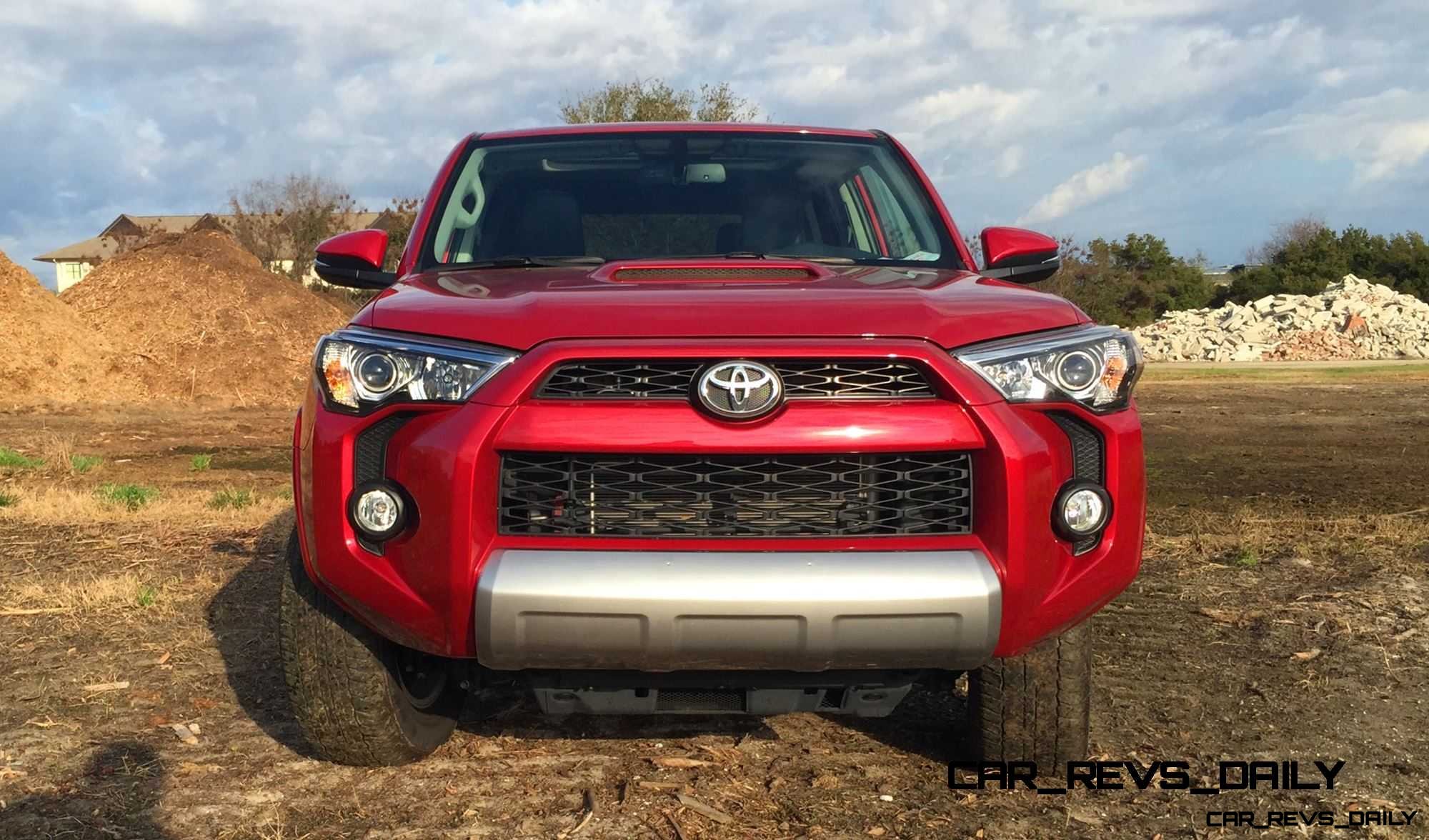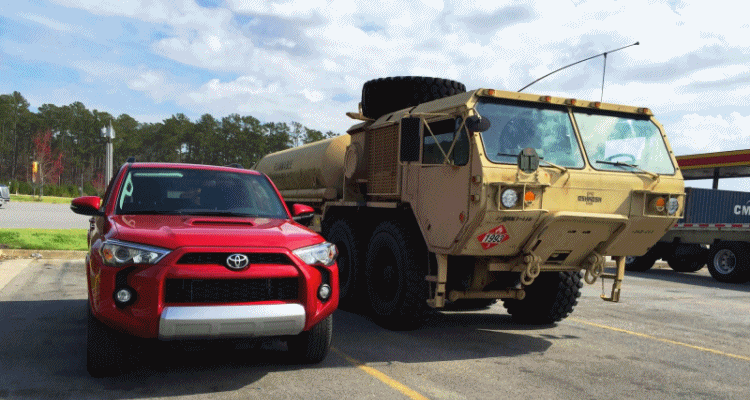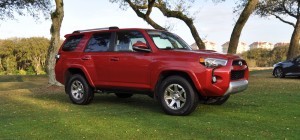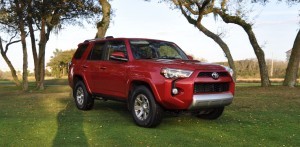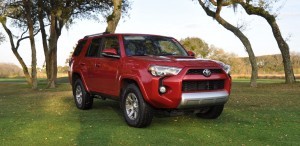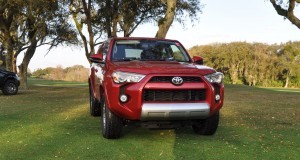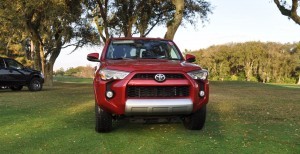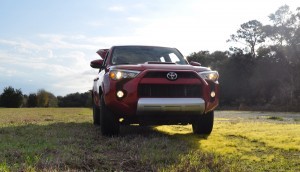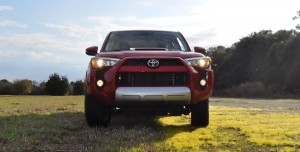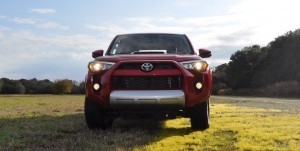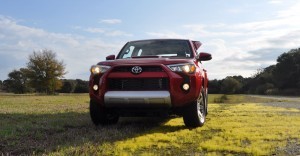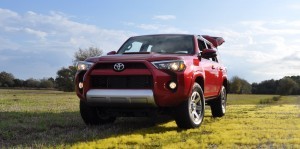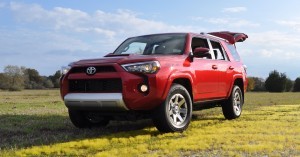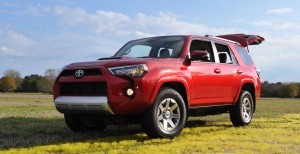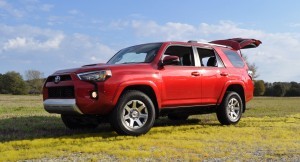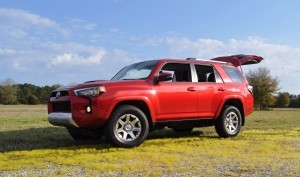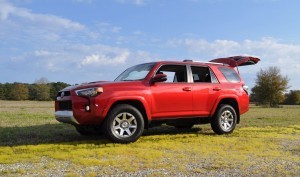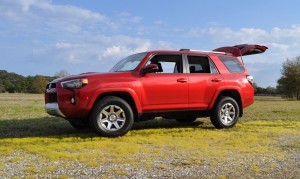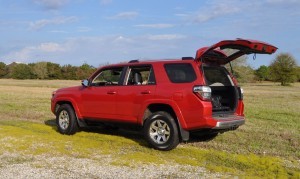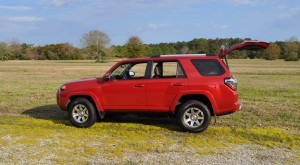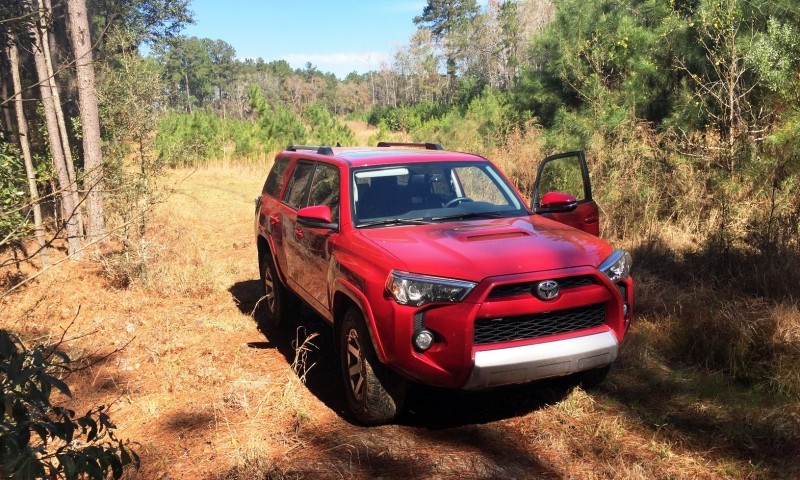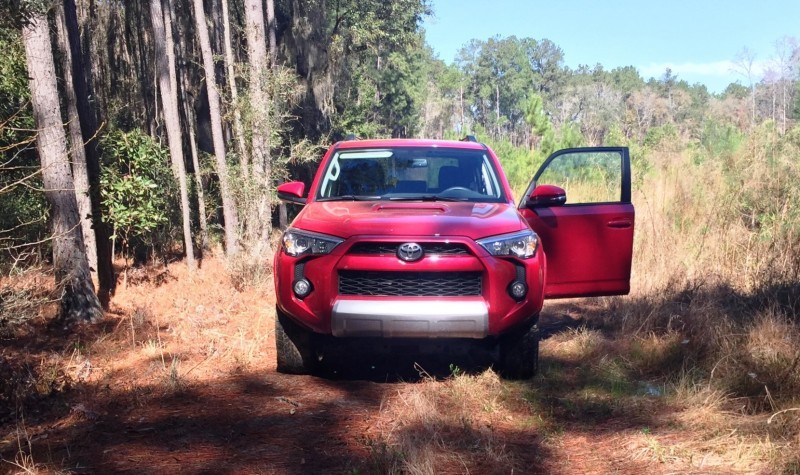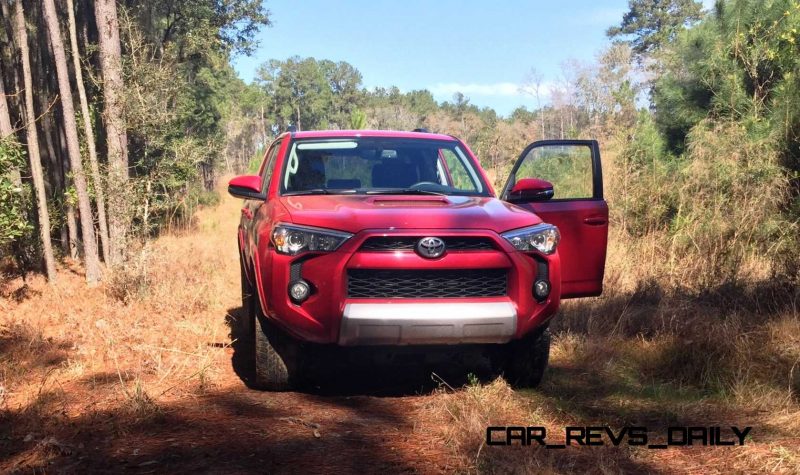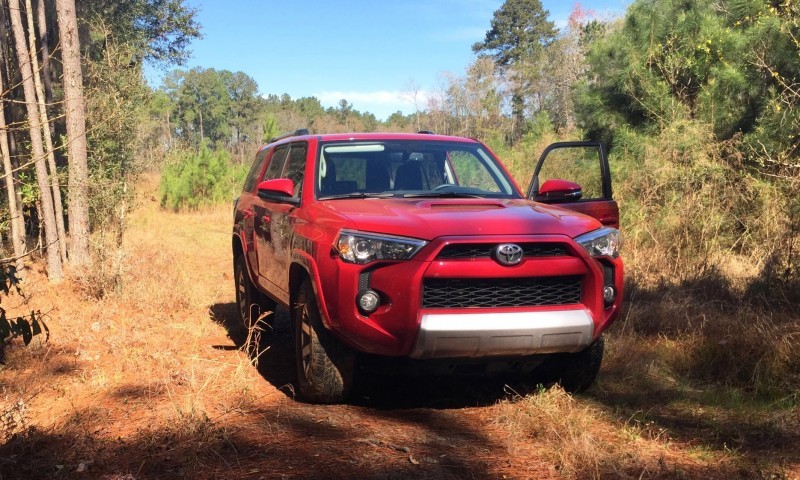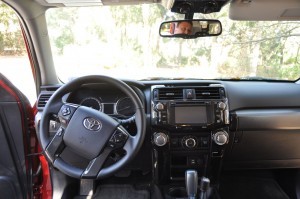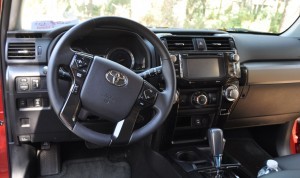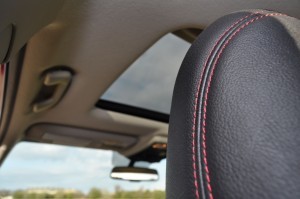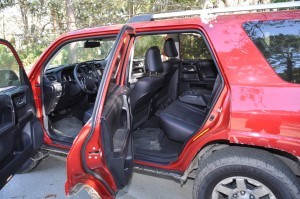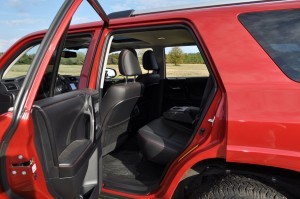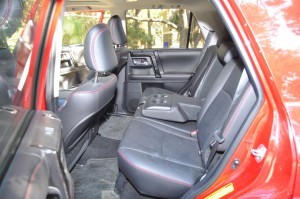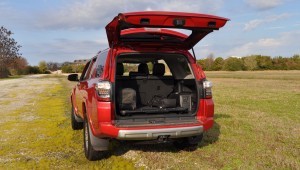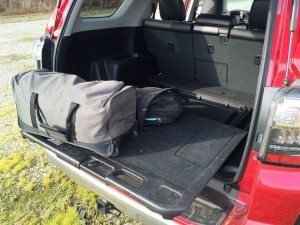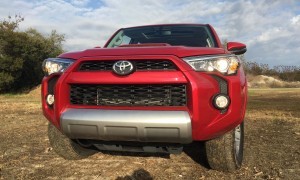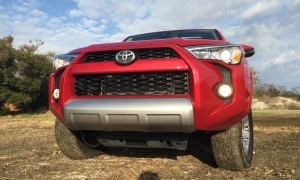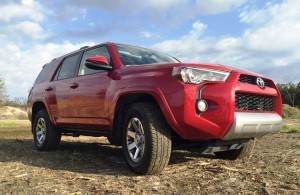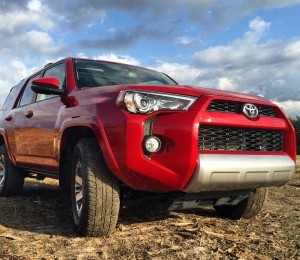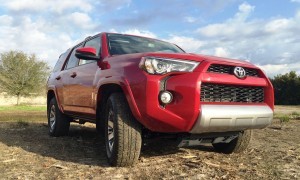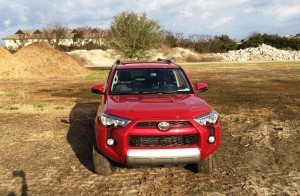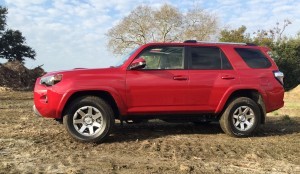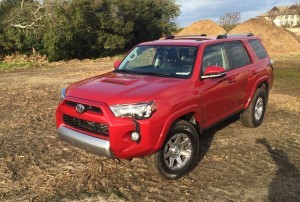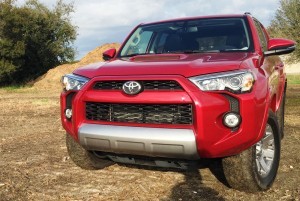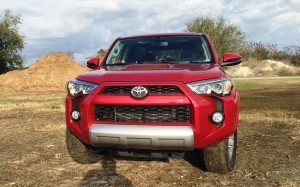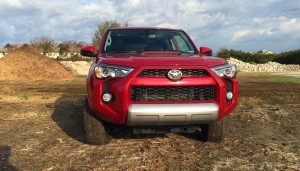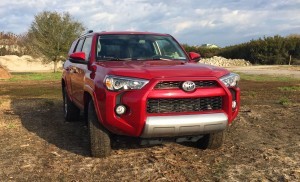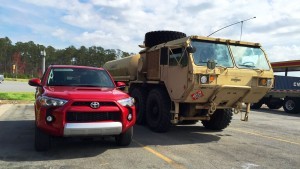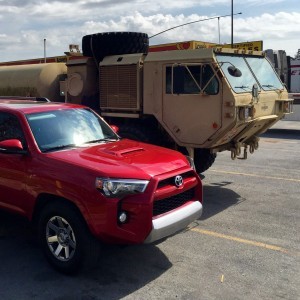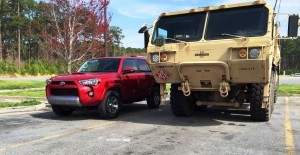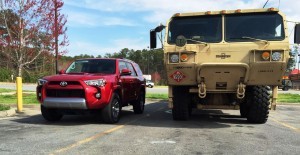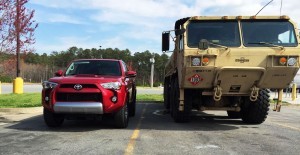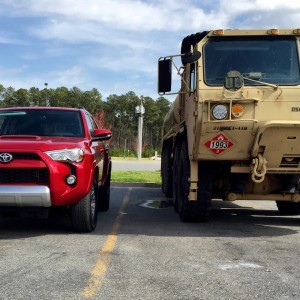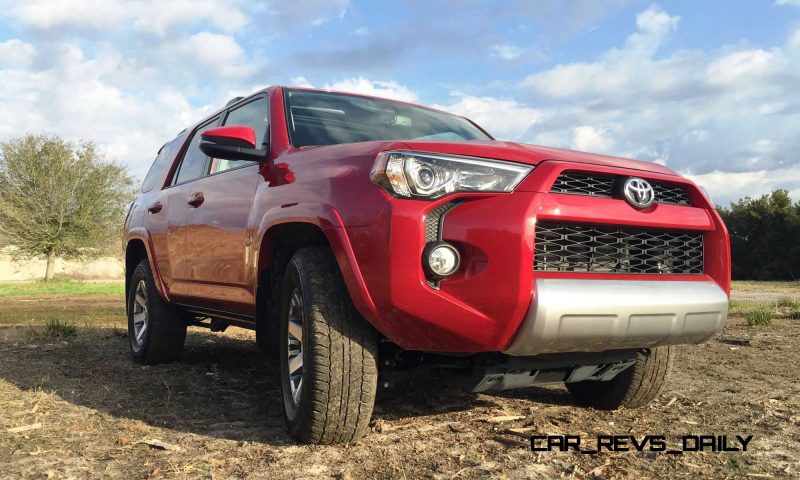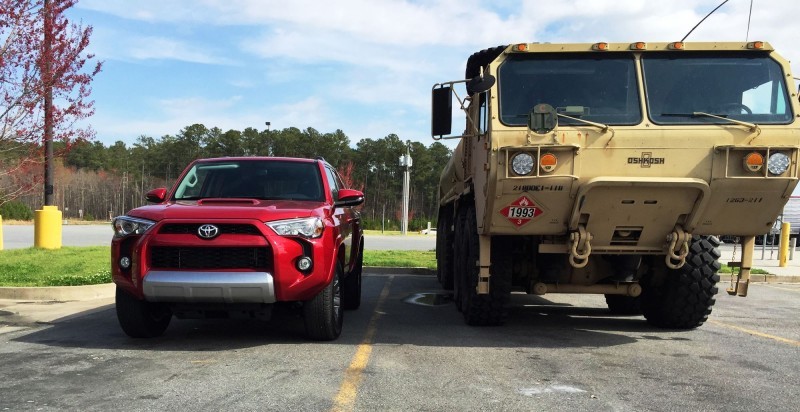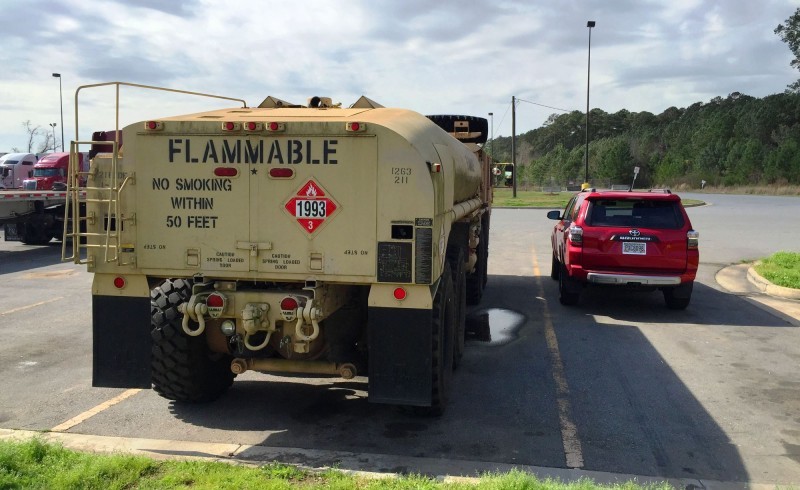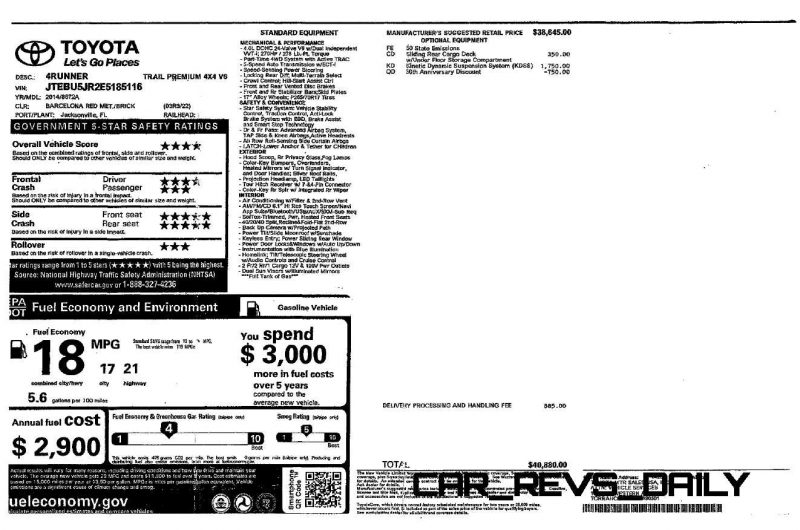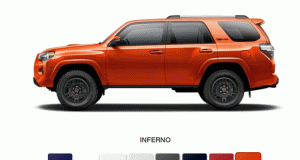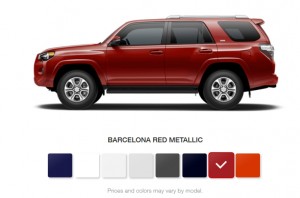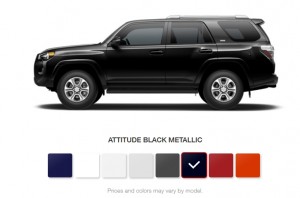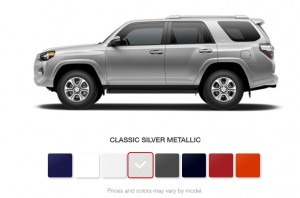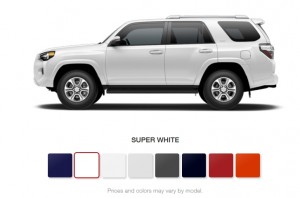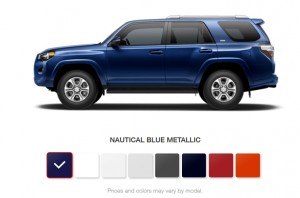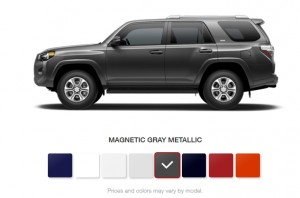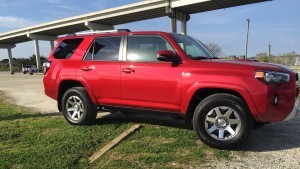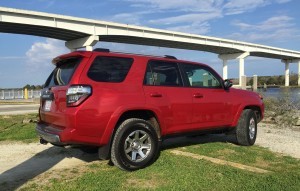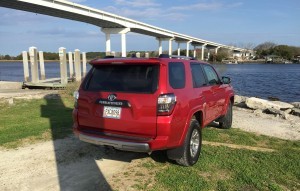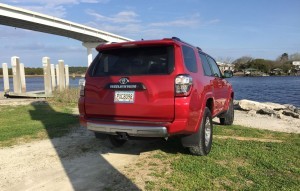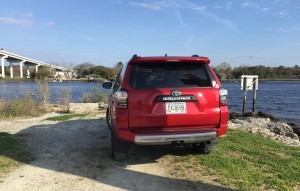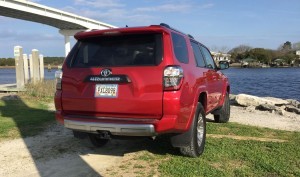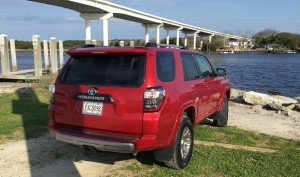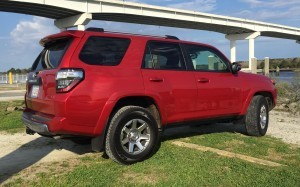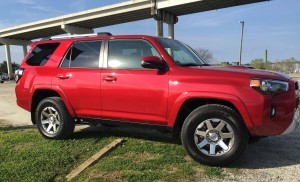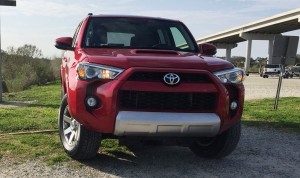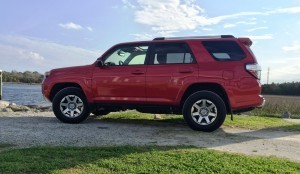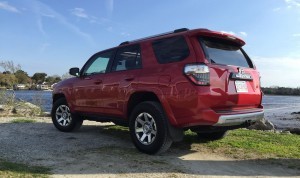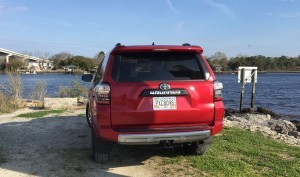 The whole SUV world of has gone soft.
The whole SUV world of has gone soft.
Crossovers from near and far have ditched their rugged truck frames in favor of cushy third rows and lazy AWD.
What is a real off-roader to do for an SUV with 2015 tech and features alongside totally invincible traction and durability?!
You can pick up a Wrangler Unlimited with its four-door hardtop giving year-round thrills, or perhaps the Nissan xTerra?
Or you can stick with the one you know delivers: the Toyota 4Runner.
This is a truck that maintains the greatest parts of its core appeal for 30 years of US sales, but enters 2015 with a sexy and butch new design outside, plus newly-comfy power seats and LED gauges inside.
How does the 4Runner feel taking on highways and off-road trails this year? And how quick and fun is the truck in a world awash with hybrids and soft-roaders?
Let’s dive in to find out! Standard headings of Exterior, Interior, Performance and Pricing below!
EXTERIOR
The new 4Runner Trail grade really hooks you with its sweet new face. Unlike the 4Runner Limited and its chrome nose, the Trail is fully monochrome and body-color aside from black grilles and the silver skid-plate accent down below.
The design of the Trail grade 4Runner starts at its standard hood scoop. Each edge of the scoop makes a line continued by the edges of a massive new single-frame grille.These two edges chop the top portion in a pinched and aggressive way, giving a great sense of power. This bulging edge flows downward into twin bumper uprights, and opens a giant breathing area for the upper and lower main grilles. Beside this big lantern jaw are two fangs of black grille with embedded round foglamps.
However you look at this new nose, there is no mistaking it for 4Runners of yore. It is a cool look on the move, too, with the slimline headlights just the right amount of intimidating. Even so, we wish the Runner had HID and LED lighting from the factory instead of its halogen bulbs for all front lighting.
Around the profile, the 4Runner Trail enjoys body-color fender flares to set off the classic proportions of a tall hood, upright windshield and blocky glasshouse. The latest 4Runner’s design helps its roof to look pretty low by SUV standards, with the giant ride height making it look Baja-ready. The 17-inch wheels and 265-series tires are as tall as ever, with the seven-spoke alloys looking tough enough for a rally.
Around back, the LED brake lamps are a new chunky design with dark grey lamp internals. The LEDs are still the dot type, looking a bit tacky versus the coolest new styles.
The tailgate is still one of the 4Runner’s best assets — with the power rear window still fantastic.
INTERIOR
The 4Runner’s cabin is its major advantage over the other hardcore SUVs available. The 2014 redesign brought the latest Entune touchscreen and nav controls, new eight-way power drivers seat and a big helping of NVH materials. The 4Runner is seriously quiet on the roads, even with giant mud/snow rubber down below. The Trail Premium trim level comes in with a base of $38,000 with Softtex seating. This is a nice techy fabric that feels part leather, part microfiber. Stays cool and is grippy, yet nice to the touch. Cloth in three colors is standard on the Trail 4Runner from just above $35,000.
In the second row, the new 4Runner is much comfier than ever. Individual bolsters make the outboard seats feel reclined and relaxed, with a good overall comfort level. No longer very low, you can recline in back there with a plush armrest. A roof or seatback multimedia option is offered in the 4Runner builder for around $1500 extra.
The trunk of the 4Runner is roomy but deep, so the luggage slider is actually a handy element. It is strong enough to sit on as a bench as well.
PERFORMANCE
We love the driving position and overall feel from behind the wheel. The 4Runner can really be chucked around through corners very happily, with its V6 engine loving a good redline scratch from hard throttle on-ramps.
With a five-speed automatic transmission and standard 4.0-liter V6 making 270-horsepower, the 2015 4Runner Trail Premium delivers a sprint pace of around 7.5-seconds to 60-mph. It feels quicker than any 4Runner in memory, with the Sport drive mode always keeping the truck ready to pounce on other traffic. In normal D mode, the 4Runner takes a heavier foot to make it downshift and dance.
OFF-ROAD TECH
On to the 4Runner’s party piece: its rockin’ chassis.
Truck frames are fantastic for towing, off-roading and overall weather-busting grip. But what downsides do they have?
Typically, they come with a bouncy ride that transfers sharp bump impacts into the cabin. They have also handled fast paved corners clumsily with lots of body roll and little playfulness.
The 4Runner Trail avoids both of these issues nicely thanks to the main option included on the test truck: the $1755 Kinetic Dynamic Suspension System. KDSS is an active decoupler of the anti-roll bars. This lets the 4Runner have a huge range of wheel travel off-road, yet be taut and sporty on the road.
The KDSS is one of the many 0ff-road tools in the 4Runner Trail’s backpack. A locking rear differential, part-time 4WD with A-TRAC, multi-terrain controls, crawl control and hill descent control. The header of the 4Runner behind the rear-view mirror ends up like a battle tank or heavy military vehicle….
Next to this OshKosh tanker, the 4Runner feels right at home. Even in its bright Barcelona Red, 4Runner Trail is clearly a truck that would be ideal for special ops.
KDSS – Does It Work?
So, does KDSS work? We did a few off-road driving sessions and are proud to report that the 4Runner made it through a series of 4-foot-deep holes easily.We broke the main rules of rock-hopping: never go alone and know the trails beforehand. We were solo and on uncharted territory. Make or brake time for the ‘Runner.
On the way into the woods, we left the 4Runner in 4-High with no terrain settings activated. The super-deep hole was passable, but only with big power to shove the nose up and out of the muck.
These were giant mud potholes that dumped the whole truck at a crazy angle while sinking a wheel down deep. To engage KDSS, you first put the 4Runner in 4-Low and activate the system via the headliner console. This hums a bit and de-couples the anti-roll bars, with the diff locking as you move forward a few feet.
On the way out of the woods, with KDSS on, you are limited in overall speeds because the 4-Low keeps the truck in first/second gear. Passing over logs and through the pits mentioned above, the 4Runner with KDSS active stayed more level overall as it sunk its tires down into the brown abyss. It also needed much less of a shove on the gas pedal to keep moving through the holes. An endorsement for KDSS. Makes 4Runner even more unstoppable.
Would be nicer if KDSS was able to engage in 4-High, however.
PRICING
The 4Runner comes in four trims, with the base SR5 stickering at $33,210 and up to $41,400 for the Limited.
The test truck came in at just below $41,000 including destination charge.
COLORS
The 4Runner looks fantastic in white, black and the new TRD Pro’s Inferno orange.
SUMMARY
All is well in 4Runner-land. This SUV reminds you of the fun of driving a really unstoppable beast. The powertrain and chassis continue without the watered-down capability of other SUVs, yet the cabin of the 4Runner is now nearly as smooth, quiet and tech-savvy as any fancy soft-roader.
For people who love the 4Runner’s adventure-travel capability, the 2015 Trail model will be a dream come true from day one. The up-level TRD Pro and Limited trims are desirable tweaks on the theme for those with the cash, but the Trail with KDSS is a sweet-spot for its affordability and great skills on and off road.
4RUNNER
Series Chronology
1985 – (CY 1984 1/2) – 4Runner introduced with 2.4L 4-cylinder engine.
1986 – Hi-Trac front suspension added.
1986 – Turbo available on SR5 grade.
1987 – SR5 trim available on both passenger and truck models.
1987 – Minor exterior styling revision.
1988 – 3.0L V6 engine available.
1989 – Second generation introduced.
1989 – 2WD 4Runner available.
1990 – Among “Best Buys” – Consumers Digest magazine.
1990 – “Best Compact SUV in Initial Quality,” J.D. Power & Associates.
1991 – “Best Compact SUV in Customer Satisfaction,” J.D. Power.
1991 – “Best Compact SUV in Initial Quality,” J.D. Power.
1992 – Minor exterior styling revision.
1992 – “Best Compact SUV in Customer Satisfaction,” J.D. Power.
1992 – “Best Compact SUV in Initial Quality,” J.D. Power.
1993 – “Best Compact Sport Utility,” IQS, J.D. Power.
1994 – Safety modifications, optional 4-wheel ABS on V6 models.
1994 – “Best Compact SUV in Initial Quality,” J.D. Power.
1996 – Third generation introduced.
1996 – 2.7L 4-cylinder and 3.4L V6 engines available.
1996 – “Compact 4-Door SUV Best Buy” Runner-up, Four Wheeler.
1996 – “Most Appealing Compact SUV,” J.D. Power.
1997 – Introduction of 2WD SR5 model.
1997 – “1997 Top Three Vehicles in Initial Quality – Compact SUV,” J.D. Power.
1997 – “Best SUV,” Consumer Reports.
1997 – “Top 10 Trucks Overall Resale Value After Three Years of Ownership,”
ADP Autosource Survey.
1997 – “1997 Total Quality Award – Medium SUV Segment,” Strategic Vision, Inc.
1998 – Minor interior changes.
1999 – New, standard multi-mode 4WD system on 4Runner Limited, redesigned
front fascia and numerous upgrades on all 4Runner models
1999 – “Best Compact SUV in Initial Quality,” J.D. Power
1999 – “Best Compact SUV Segment,” J.D. Power
2000 – Among Consumer Guide’s Recommended Midsize Sport-Utility Vehicle
2001 – Receives standard-equipped 3.4L V6 engine and automatic transmission, new
interior features and three new colors
2001 – Among Consumer Guide’s Recommended Midsize Sport-Utility Vehicle
2002 – 4Runner receives minor enhancements.
2002 – Intellichoice named Best Overall Value Compact Sport Utility Class Over $20,000
2002 – Intellichoice named Best Overall Value Sport Utility Under $28,000 (SR5 2WD)
2003 – Fourth generation 4Runner introduced.
2003 – Truckin’s SUV Magazine “SUV of the Year” award
2003 – Recipient of a Popular Science’s “Best of What’s New” award
2003 – Among Consumer Guide’s Recommended Midsize Sport-Utility Vehicle
2004 – Optional third-row seat available on Limited and SR5 models, backup camera available with Navigation system.
2004 – Named “Most Dependable Midsize Sport Utility Vehicle” by J.D. Power & Associates.
2004 – Among Consumer Guide’s Recommended Midsize Sport-Utility Vehicle
2005 – Receives engine, transmission, safety and cosmetic enhancements
2005 – Named Edmunds.com Editors’ Most Wanted SUV Under $35,000
2005 – Money Magazine named 4Runner “Best Mid-Size SUV” in its “Best Car Values 2005” March 2005 issue
2005 – Among Consumer Guide’s 2005 Recommended Midsize SUVs
2006 – IntelliChoice Motorist’s Choice Award – Intermediate Utility
2007 – AutoPacific’s Vehicle Satisfaction Award (VSA) in Premium Mid-Size SUV Category
2008 – 4Runner gets standard first- and second-row side-curtain airbags, active front
headrests and a Vehicle Stability Control (VSC) cut-off switch.
2008 – AutoPacific’s Vehicle Satisfaction Award (VSA) for Premium Mid-Size SUV
2008 – AutoPacific and Intellichoice.com’s Motorist Choice Awards for Premium Mid-Size
SUV
2009 – Trail Edition package available exclusively for the 4Runner SR5 with V6 and 4WD
2009 – “Best Multi-Activity Vehicle in Initial Quality,” J.D. Power.
2009 – SEMA Show most accessory friendly vehicle award
2010 – All-New fifth generation 2010 MY 4Runner launches in November 2009
2010 – All-new 4Runner named “Four Wheeler of the Year” by Four Wheeler Magazine.
2011 – IntelliChoice “2011 Best Overall Value” – SUV segment
2011 – J.D. Power & Associates Vehicle Dependability Study “Most Dependable Midsize
Crossover/SUV”
2014 – Kelley Blue Book” “2014 Best Overall Value – Top 10 Vehicle
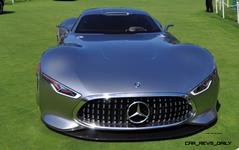
Tom Burkart is the founder and managing editor of Car-Revs-Daily.com, an innovative and rapidly-expanding automotive news magazine.
He holds a Journalism JBA degree from the University of Wisconsin – Madison. Tom currently resides in Charleston, South Carolina with his two amazing dogs, Drake and Tank.
Mr. Burkart is available for all questions and concerns by email Tom(at)car-revs-daily.com.

